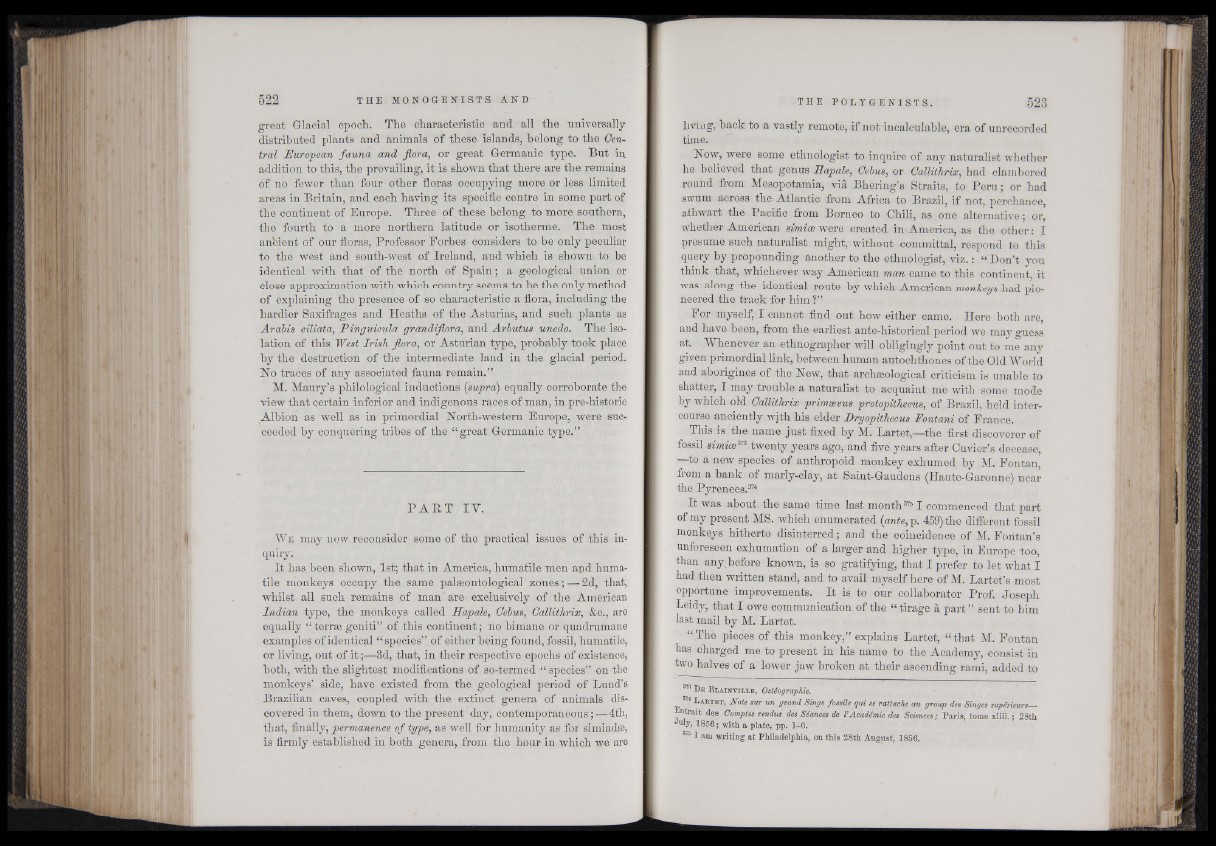
great Glacial epoch. The characteristic and all the universally
distributed plants and animals of these islands, belong to the Central
European fauna and flora, or great Germanic type. But in
addition to this, the prevailing, it is shown that there are the remains
of no fewer than four other floras occupying more or less limited
areas in Britain, and each having its specific centre in some part of
the continent of Europe. Three of these belong to more southern,
the fourth to a more northern latitude or isotherme. The most
ancient of our floras, Professor Eorhes considers to he only peculiar
to the west and south-west of Ireland, and which is shown to be
identical with that of the north of Spain; a geological union or
Close approximation with which country seems to be the only method
of explaining the presence of so characteristic a flora, including the
hardier Saxifrages and Heaths of the Asturias, and such plants as
Arabis ciliata, Pinguieula grandiflora, and Arbutus unedo. The isolation
of this West Irish flora, or Asturian type,1 probably took place
by the destruction of the intermediate land in the glacial period.
Ho traces of any associated fauna remain.”
M. Maury’s philological inductions (supra) equally corroborate the
view that certain inferior and indigenous races of man, in pre-historic
Albion as well as in primordial Horth-western Europe, were succeeded
by conquering tribes' of the “ great Germanic type.”
P A R T IV.
We may now reconsider some of the practical issues of this inquiry.
It has been shown, 1st; that in America, humatile men and humar
tile monkeys occupy the same palaeontological zones ; —• 2d, that,
whilst all such remains of man are exclusively of the American
Indian type, the monkeys called Hapale, Oebus, Callithrix, &c., are
equally “ terræ geniti” of this continent; no bimane or quadrumane
examples of identical “ species” of either being found, fossil, humatile,
or living, out of it ;—3d, that, in their respective epochs of existence,
both, with the slightest modifications of so-termed “ species” on the
monkeys’ side, have existed from the geological period of Lund’s
Brazilian caves, coupled with the extinct genera of animals discovered
in them, down to the present day, contemporaneous ;—4th,
that, finally, permanence of type, as well for humanity as for simiadse,
is firmly established in both genera, from the hour in which we are
living, back to a vastly remote, if not incalculable, era of unrecorded
time.
How, were some ethnologist to inquire of any naturalist whether
he believed that genus Hapale, Cebus, or Qallithrix, had clambered
round from Mesopotamia, via Bhering’s Straits, to Peru; or had
swum across the Atlantic from Africa to Brazil, if not, perchance,
athwart the Pacific from Borneo to Chili, as one alternative; or,
whether American simice were created in America, as the other: I
presume such naturalist might, without committal, respond to this
query by propounding another to the ethnologist, viz.: “ Don’t you
think that, whichever way American man came to this continent, it
was along the identical route by which American monkeys had pioneered
the track for him ?”
Eor myself, I cannot find out how either came. Here both are,
and have been, from the-earliest ante-historical period we may guess
at. Whenever an ethnographer will obligingly point out to me any
given primordial link, between human autochthones of the Old World
and aborigines of the Hew, that archaeological criticism is unable to
shatter, I may-trouble a naturalist to acquaint me with some mode
by which old Qallithrix primsevus protopithecus, of Brazil, held intercourse
anciently with his elder Dryopithecus Fontani of Eranc.e.
This is the name just fixed by M. Lartet,—the first discoverer of
fossil szWte373. twenty years ago, and five years after Cuvier’s decease,
to a new species of anthropoid monkey exhumed by M. Eontan,
from a bank of marly-clay, at Saint-Gaudens (Haute-Garonne) near
the Pyrenees.374
It was about the same time last month375 1 commenced that part
of my present MS. which enumerated (ante, p. 459) the different fossil
monkeys hitherto disinterred; and the coincidence of M. Fontan’s
unforeseen exhumation of a larger and higher type, in Europe too,
than anybcfore known, is so gratifying, that I prefer to let what I
had then written stand, and to avail myself here of M. Lartet’s most
opportune improvements. It is to our collaborator Prof. Joseph
Leidy, that I owe communication of the “ tirage á part ” sent to him
last mail by M. Lartet.
“ The pieces of this monkey,” explains Lartet, “ that M. Fontan
bas charged me to present in his name to the Academy, consist in
two halves of a lower jaw broken at their ascending rami, added to
878 D e B l a in v i l l e , Ostéographie.
74 L a r t e t , Note sur un g%and Singe fossile qui se rattache an group des Singes supérieurs—
Entrait des Gomptes rendus des Séances de l’Académie des Sciences; París, tome xliii.; 28th
b’, 1856; with a plate, pp. 1-6.
8,51 am writing at Philadelphia, on this 28th August, 1856.